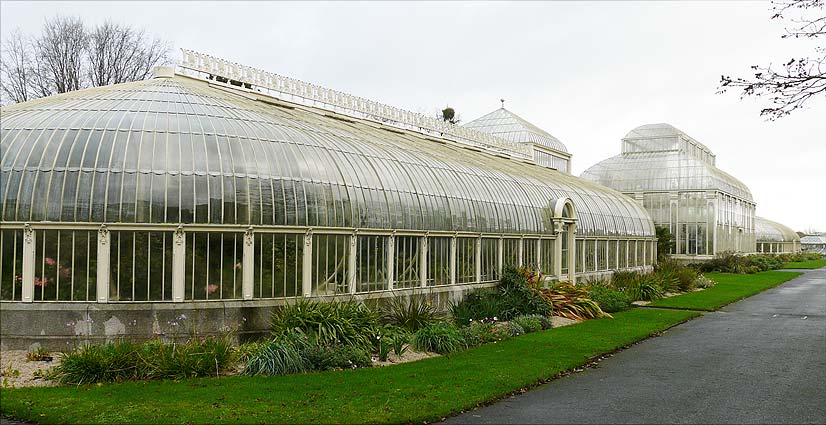

Situated at Glasnevin, just a couple of miles from the the city centre, the National
Botanic Gardens are worth visiting at any time of the year. And entrance is
free of charge! My exuse for including the gardens in this website is that there
are several plants of 'citrus interest'. Photos are from my visit in November
2009. |
In the rockery section there is an old, gnarled and fruitful specimen of Poncirus trifoliata which reminded me strongly in form and position of the one in Edinburgh's botanic garden. In early November, the leaves and fruit were starting to colour yellow. |
The gardens boast two magnificent Victorian glasshouses. The curvilinear range (left)
was opened by Queen Victoria herself in 1849. It was completely restored in
1995. |
The Great Palm House (below) was built in 1883 to replace an earlier wooden structure
which was blown down. |
More unusual is the existance of two outdoor citranges - one labelled as the variety Morton. Citranges are a hybrid between the sweet orange
and Poncirus trifoliata, the Japanese Bitter Orange. Although old, the plants are small and carried no fruit
when I visited, but they are the only specimens I have seen growing in any
public garden in the British Isles. Sadly, they are growing on a shady wall
and the trunks at ground level have clearly rotted at some time, possibly due
to the over-moist conditions. From the look of the stems, under good conditions
these plants would be of fruiting size instead of only about 4' (1.2m) tall. Note that the garden catalogue lists these under the botanical name xCitroncirus webberi. I believe that the "xx" in the accession number indicates the year of planting is unknown. |
My first visit to the Dublin Botanic Gardens must have been about 15 years ago. During
that visit I saw a small potted specimen of Microcitrus australis, the Australian native Round Lime. I was just becoming interested in these species
and noticed the obvious discrepancy in leaf size and shape between the Dublin
plant and my own recently germinated seedlings. I had the temerity to write to
the Director of the gardens suggesting that the specimen could not be Microcitrus
australis because it did not have the thin linear leaves of my plants. I now
know that the linear leaves are just a juvenile form and are not found on a
mature plant, or any grafted from one. So, during my November 2009 visit I searched for this plant without success. Finally, I asked a gardener, and I was passed from one member of staff to another, until I arrived at the greenhouses to the south of the car park. These greenhouses are not open to the public, but are home to a large number of plants not currently on display. It was suggested the Microcitrus could have been moved to the outside areas between the glasshouses. To my amazement we finally located the plant (slightly mis-labelled as Mitrocitrus) growing reasonably happily with just the protection from the nearby glasshouses. |
Also listed in the gardens complete catalogue: Citrus × limonia, Citrus × paradisi, Citrus aurantium, Citrus hystrix, Citrus japonica, Citrus maxima, Citrus sinensis, Citrus taitense |
page created 3rd December 2009 |